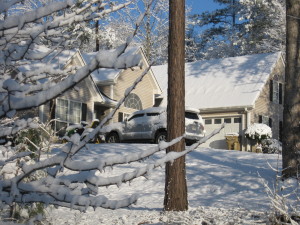
Why, oh why, do otherwise perfect Southerners lose their minds and their ability to drive automobiles when they hear it might snow?
Yes, snow might gently fall in our region tonight.
That means by 9 PM there will be less milk and bread in stores than if we had food riots. The “S” word also means some schools are planning on opening two hours late tomorrow. Just because it might snow.
We bring you this bulletin from Georgia DOT District Engineer for Northeast Georgia Bayne Smith: “We are continuously monitoring current weather conditions as winter weather is predicted for Northeast Georgia overnight. Before you head out on the roads tomorrow please check the weather and road conditions.”
We’re going to survive, folks. Tomorrow’s temperatures are expected to hit 50 degrees. Even Frosty the Dang Snowman cannot survive in that heat.
But … just because everybody else is going to freak out on the highways tomorrow, we ask you to be alert for these potential hazardous situations during winter weather:
- Bridges, as black ice forms there first and can reform quickly
- Highest elevations or gaps in North Central and Northeast Georgia
- Fallen trees, root systems are weak because of the drought and heavy rains, with the potential of strong winds trees will likely fall onto or adjacent to roadways
- Traffic signals not operating because of power outages
- High profile vehicles will be difficult to control in high winds
Mr. Smith also said, “Strong wind gusts are possible and weather reports call for slight accumulations of snow in the higher elevations of the Mountains. So we encourage all motorists to stay off the roadways if possible. If you must be on the roads, please slow down, engage the lower gear of your vehicle for additional traction and use extreme caution particularly as you approach bridges. If you approach a traffic signal that is dark with no color lit then treat the intersection as a four way stop by waiting your turn to move. If the signal flashes yellow then cautiously proceed through the intersection. If the signal flashes red then stop and wait for a safe time to proceed knowing the other roadway has the right of way.”

The DOT will send out “scout teams” tonight. (Really? You don’t believe me? Really? Would I lie to you?) Teams of two scouts will scour these counties at 8 PM in search of snowflakes: Dawson, Forsyth, Habersham, Hall, Lumpkin, Rabun, Towns, Union and White counties. Another team will report to I-85 in Gwinnett at 3 a.m. to check its condition. Crews will be called in, if needed, overnight.
Just because I don’t take this snowstorm’s threat very seriously doesn’t mean the DOT doesn’t have to, right?
Motorists are urged to:
- Slow down and stay behind the snowplows. The road behind the plow will be the safest place to drive. Allow at least ten car lengths between your vehicle and snowplows or hopper spreaders.
- Do not pass. The plows are wide, and sometimes a group of trucks will work in tandem to clear snow quickly, especially on major highways.
- Be particularly aware of black ice conditions on surfaces such as bridge decks and entrance and exit ramps late tomorrow night and the early hours of Friday morning.
- Remember that technology helps, but only to a point. Four-wheel drive, anti-lock brakes and traction control are beneficial advancements in today’s cars, trucks and SUVs, but they can’t take the place of good driving habits and the need to reduce speed on snowy or icy roads.
General Preparedness
- The Georgia DOT maintains a staging area in most counties. These county maintenance buildings each stockpile salt, fine gravel, fuel and any supplies needed for emergencies.
- The Georgia DOT’s Highway Emergency Response Operators (HEROs) will be monitoring traffic along I-85, I-75, I-20 and I-285 in the metro Atlanta area in order to assist motorists with car trouble or to help clear accidents and stalls from the roadway.
- In the metro Atlanta area, the traffic operators at the Transportation Management Center in southeast Atlanta constantly monitor the traffic cameras along the interstates looking for signs that roads are icing up and relay those locations to the maintenance office.
- Communications personnel across the state will be at the Transportation Management Center and the district offices to provide constant updates to the media.
- Communications personnel will be providing updates to the public via Facebook (http://www.facebook.com/
GeorgiaDOT) and Twitter ( http://twitter.com/ gadeptoftrans). - Citizens may also access roadway conditions at the Department’s winter weather web site: (http://www.dot.ga.gov/
winterweather ). - We monitor all local weather reports on television and radio, in addition to receiving regularly updated weather information from national sources.
Snow and Ice Removal
- Keeping the roads safe for emergency vehicles is our first priority.
- Interstates are cleared first, and then state routes from the most heavily traveled to the least traveled.
- The most common de-icing mixture is a 3:1 ratio of small ‘89 stone’ and sodium chloride (salt). It is affective in breaking up ice and snow until temperatures drop below 25 degrees.
- If temperatures dip below 25 degrees, calcium chloride is added to the stone/salt mixture.
- Salt brine can be used to pre-treat roadways to prevent ice from bonding to the roadway surface.
- The tandem dump trucks mounted with spreaders can carry approximately 8 to 12 tons of the de-icing mixture.
- The Georgia DOT will bring in crews and equipment from other areas of the state to help with a particularly hard-hit area whenever necessary.
Georgia DOT urges travelers to exercise caution and call 511 for updated information on roadway conditions before getting on the road during a winter weather event. Georgia 511 is a free phone service that provides real-time traffic and travel information statewide, including winter weather closures, reports of icing or other hazardous conditions on interstates and state routes. Callers also can transfer to operators to request assistance or report incidents 24 hours a day, seven days a week. More information is available atwww.511ga.org. For more information on Georgia DOT, please visitwww.dot.ga.gov or subscribe to our Press ReleaseRSS feed. You also may follow us onFacebook (www.facebook.com/GeorgiaDOT)and Twitter (http://twitter.com/


